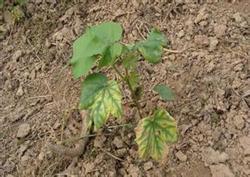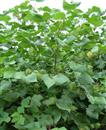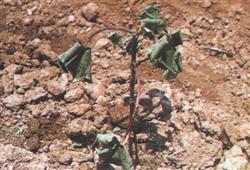How to alleviate the "Cancer" of insect-resistant Cotton

Fusarium wilt of cotton is habitually called cancer by farmers. In fields where the disease has occurred, planting cotton later is often prone to cancer, or even more serious year after year, because once this kind of bacteria lurks in the soil, it is difficult to eradicate, and when it comes to suitable climatic conditions, it is easy to relapse. In recent years, a number of insect-resistant cotton varieties have been introduced and bred in China, and most of them have good insect resistance and high yield. in years with normal climate, the yield-increasing advantage of insect-resistant cotton varieties is also very significant. However, the weakness of insect-resistant cotton is that there is some lack of disease resistance. when it encounters an unfavorable climate of continuous overcast and rain from early June to early July, some insect-resistant cotton is even seriously susceptible. Among them, the infection rate of some insect-resistant cotton varieties is about 40%, although insect-resistant, there will still be a reduction in production. At the same time, peach is concentrated in most insect-resistant cotton varieties, and it is easy to senescence prematurely in the later stage, which deserves special attention in production. For the cancer of cotton, in addition to selecting disease-resistant varieties to enhance disease resistance, according to my experience in many years of investigation and summary, improving water system facilities and fertilization technology can enhance disease resistance. First, increase the application of all kinds of organic fertilizers. I have applied bio-organic compound fertilizer in several cotton fields where the incidence of cotton Fusarium wilt reached about 20%. In that year, the number of infected plants dropped to less than 5%, which was about 15% lower than that of neighboring cotton fields that did not apply bio-organic compound fertilizer. This is because the secretion of bio-organic fertilizer can inhibit the reproduction and invasion of bacteria. Therefore, one can apply 3000 to 4000 kilograms of organic fertilizer accumulated by farmers per mu, two can apply bio-organic compound fertilizer of different bacteria, about 75 kilograms per mu, and three can apply high-energy organic compound fertilizer, about 100 kilograms per mu. Local areas can be flexibly selected according to local conditions. Second, increase the amount of potash fertilizer. Years of cotton production practice shows that the demand for potash fertilizer of conventional cotton is relatively less than that of insect-resistant cotton, and now the market share of insect-resistant cotton is larger, while the demand of potash fertilizer of insect-resistant cotton is more than double that of conventional cotton. The phenomenon of potassium deficiency in insect-resistant cotton planted in the field is relatively common. The application of potassium fertilizer can not only enhance the defense against Fusarium wilt, but also prevent physiological diseases caused by potassium deficiency (blight) and red leaf stem blight which is easy to break out after continuous high temperature and rainstorm, and avoid premature senescence. Generally, the amount of potash fertilizer applied per mu is not less than 30kg. Third, heavy application of flower and boll fertilizer and peach fertilizer. When cotton enters the flower and boll stage, it is the peak period of fertilizer demand. About 20 kg of multi-component compound fertilizer should be applied per mu, and about 15 kg of urea should be applied per mu when there are about 3 peaches per mu. At the same time, spraying potassium dihydrogen phosphate and boron on the root can effectively prevent the premature senescence and collapse of cotton. Fourth, improve the facilities of the water system. In the year when Fusarium wilt occurred seriously, we often found that in the same cotton field prone to Fusarium wilt, the incidence rate in the area with high groundwater level was much higher than that in the area with low groundwater level. The results showed that the resistance of cotton with poor root system to Fusarium wilt was weakened. Cotton seedlings first root, cotton field water system facilities are related to the strength of cotton roots, good roots of cotton, can also enhance the resistance to Fusarium wilt. Therefore, high-yield cotton fields should be connected with drainage ditches, chamber ditches and waist grooves, and the heavy rain with a daily fall of 100 mm can drain, fall, filter, and rain can live in the field dry.
- Prev

Field Management Measures of Xiantao Cotton in Lower Stage
(1) The investigation results of peach planting are as follows: the cotton planting area of professional cooperatives in Chengdu is 104.38 million mu, the average density per mu is 1640 plants, the plant height is 134.9 cm, the fruit branches are 19.7, the mature peach is 15.25, the small peach is 18.03, the flower is 2.4, the bud is 27.56, the shedding rate is 17.66%(the total fruit node is 66.85)...
- Next

How to control cotton blight
Cotton Rhizoctonia solani, also known as root rot, black root disease, the pathogen is Rhizoctonia solani. Infection of pathogen before seed germination can cause rotten seed, and infection after germination to pre-unearthed can cause rotten bud. After the cotton seedlings were unearthed, the yellow-brown disease spot appeared at the base near the soil surface at the initial stage, and the disease spot gradually expanded and surrounded the whole base. Senior farmers.
Related
- The first cup of black tea in spring, the flavor and history of tea gardens in Kenya, Africa
- The computer can not only choose potatoes, but also grow tea rice. AI will grow winter oolong tea champion.
- It is not only the inflated tea bitten by insects, but also engraved with the four seasons tea in Beipu.
- The Oriental Beauty Tea Festival in Zhuxian County takes the stage at the weekend to experience the plus-size feast of oil tea.
- & quot; Oriental Beauty Tea & Exploration of Emei in Hsinchu, the hometown of quot;
- The new variety of strawberry "Tainong 1" dessert is the first choice with mellow aroma. Crimson gorgeous
- History of Tea in Taiwan: from Wild Inner Mountain to Export Tea Garden
- Two types of Taiwan Oriental Beauty Black Tea won the British three-Star Award for Childhood Tea Xiang Zhang Jiaqi changed from pilot to champion tea maker.
- Banana species and varieties: the planting history of Taiwan Xianren banana and dwarf banana is long, is banana disease resistant?
- Coffee planting Technology: Qianjie Coffee from Seedling to harvesting

